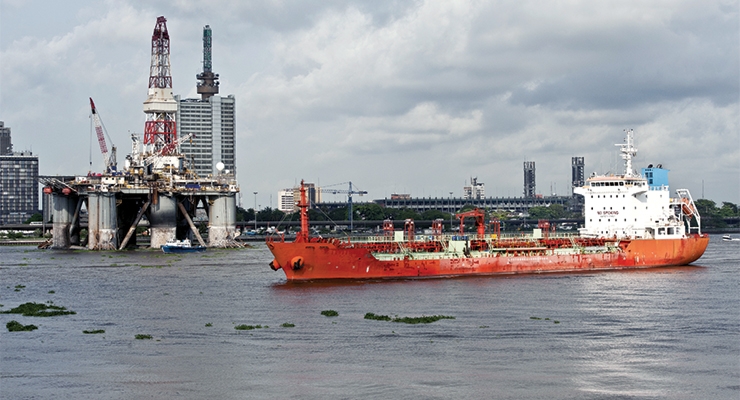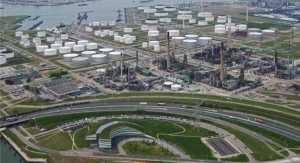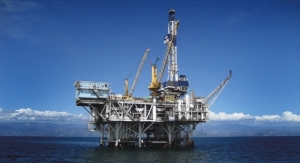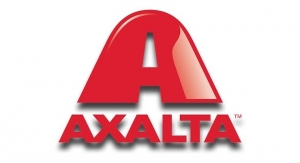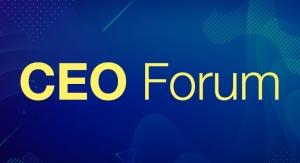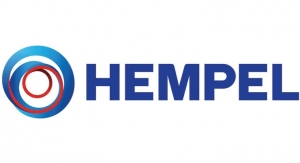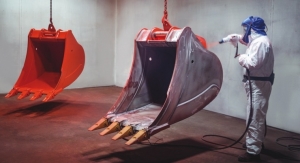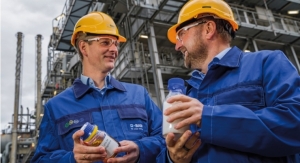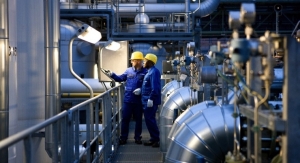Shem Oirere, Africa Correspondent05.31.19
The West Africa offshore oil and gas extraction market has remained resilient despite recent volatile global oil prices that led to temporal scaling down of some upstream exploration and production projects by some international exploration and production companies.
This resilience of the region’s offshore market sustained the performance of the offshore equipment and infrastructure supply market credited for the increase in the demand for quality marine paints and coatings to protect against corrosion, provide a nonslip-surface, and improve the assets’ aesthetic qualities.
As the global oil prices recover, West Africa continues to experience an increase in oil and gas exploration, production and storage equipment and infrastructure, a large share made of steel that is being installed in extremely harsh deepwater environments. This has raised the demand for corrosion protection paints and coatings such as polyurethanes, acrylic, polyesters, epoxy and alkyd for maximum performance of
the installations.
Investment opportunities in West Africa’s offshore space has opened a window for the supply of floating production storage and offloading (FPSO) units, drillships, sub-sea pipelines, mobile rigs, fixed platforms and other specialty vessels that require not only coatings that make them look attractive but with capability to protect them from contamination and corrosion in the aggressive marine environments where they are located.
Analysts say West Africa offshore oil and gas operations are likely to intensify in 2019 as more exploration and production companies implement key projects for extracting the hydrocarbon resources to feed the receptive world market especially as global oil prices continue to show signs of stabilization.
Leading global oil and gas companies BP, Cairn Energy, Woodside, FAR Ltd and Petronas are separately progressing their offshore projects in Senegal and Mauritania as the search for and extraction of hydrocarbons in West Africa intensify with the demand for associated equipment and infrastructure set to grow to match expansion of deep and ultra deep water exploration and production operations.
Some of West Africa’s offshore oil and gas projects that require paints and coatings consuming equipment and infrastructure include Tortue/Ahmeyim on the Mauritania and Senegal cross border, SNE oil fields in Senegal and the Samo prospect in Gambia.
The deepwater and ultra-deepwater exploration and production activities will drive growth not only of offshore paints and coatings for maintenance work in West Africa but also in countries where offshore oil and gas equipment are sourced, particularly Asia.
Countries such as Cote d’Ivoire, Nigeria, Sierra Leone, Ghana, Senegal and Liberia have announced grand plans to tap their vast unexploited reserves under partnerships between respective national oil companies and international oil exploration and production firms that have been attracted to West Africa’s deepwater and ultra-deepwater assets.
The plans include scaling up oil and gas production and inviting bids for open offshore blocks to potential local and international exploration and production companies.
The anticipated growth of West Africa’s offshore paints and coatings market is closely linked to the current global trend largely influenced by increasing deep and ultra-deepwater oil and gas
extraction activities.
“Ongoing advances in drilling techniques, the development and higher rate of extraction from reserves and development of well stimulation models are expected to further surge the market growth,” according to Allied Market Research, a global market researcher and analyst.
“Moreover, the use of epoxy coatings in pipelines is enhancing the internal and external durability which helps in providing resistance against high temperatures, chemicals and corrosion,” it said in its report “Offshore Oil & Gas Paints and Coatings Market 2017-2023.”
“Polyurethane is used at all stages of extraction of oil and gas as it provides complete resistance against various hazards, such as corrosiveness, pressure, abrasion, and heat resistance,” the
report said.
“Polyurethane offers the maximum market potential in the global offshore oil and gas paints and coatings market, owing to rapid industrialization and expansion of oil and gas industries,”
it said.
“Polyurethane coatings and elastomers are effective against refurbishment and wear and tear issues in pipes, and thus effectively increase the durability leading to the
market growth.”
The link between West Africa and the global trend in offshore paints and coatings is important because the market relies heavily on Asian-built offshore vessels a trend attributed to the vessels having a competitive advantage due to the low cost of labor.
For example, Italian oil major, Eni, the operator of Offshore Cape Three Points (OCTP), an integrated deepwater project in Ghana, contracted Yinson Holding Ltd to convert a petrol tanker at Singapore’s Keppel Shipyard for the production and processing of oil from the West Africa country’s offshore producing fields.
Elsewhere, BW Offshore recently signed an agreement with Eni’s affiliate, Nigerian Agip Exploration, to extend to June 30, 2019, the operation of ABO FPSO, a former 132,500dwt tanker known as Grey Warrior which was converted into an FPSO by Keppel.
Moreover, many more companies own FPSO unit that can move freely within Africa and all require refurbishment and maintenance that drives growth in the use of offshore paints and coatings. Companies such as Prosafe, ExxonMobil, Perenco, Oceaneering, Chevron, Saipem, Shell, ConocoPhillips, Blue Water, Zaafarana and BP own FPSO vessels the region and could contribute to the growth of the market.
Realizing the huge potential existing for small and medium offshore vessels and construction works in Africa, some manufacturers and suppliers are strengthening their operations in the region to meet current and future demand.
Danish coatings supplier, Hempel, had three years ago set up its first manufacturing plant in South Africa, saying the achievement was part of the company’s drive to “become one of the world’s top-10 largest coatings suppliers by the end of 2015.”
The manufacturing facility, Hempel, said “will manufacture coatings for the decorative, protective and marine industries and will serve customers in Sub-Saharan Africa.”
“The new factory will allow us to reduce lead times, streamline our supply chain, increase our ability to serve the regional market and offer a more complete assortment to our customers in the decorative, protective and marine industries,” according to Hempel.
With the world oil prices appreciating and global demand for natural gas remaining steady, offshore exploration and production companies are likely to scale up their capital expenditure in West Africa hence increasing investment in offshore equipment and infrastructure that will continue to support the growth of the offshore paints and coatings market.
This resilience of the region’s offshore market sustained the performance of the offshore equipment and infrastructure supply market credited for the increase in the demand for quality marine paints and coatings to protect against corrosion, provide a nonslip-surface, and improve the assets’ aesthetic qualities.
As the global oil prices recover, West Africa continues to experience an increase in oil and gas exploration, production and storage equipment and infrastructure, a large share made of steel that is being installed in extremely harsh deepwater environments. This has raised the demand for corrosion protection paints and coatings such as polyurethanes, acrylic, polyesters, epoxy and alkyd for maximum performance of
the installations.
Investment opportunities in West Africa’s offshore space has opened a window for the supply of floating production storage and offloading (FPSO) units, drillships, sub-sea pipelines, mobile rigs, fixed platforms and other specialty vessels that require not only coatings that make them look attractive but with capability to protect them from contamination and corrosion in the aggressive marine environments where they are located.
Analysts say West Africa offshore oil and gas operations are likely to intensify in 2019 as more exploration and production companies implement key projects for extracting the hydrocarbon resources to feed the receptive world market especially as global oil prices continue to show signs of stabilization.
Leading global oil and gas companies BP, Cairn Energy, Woodside, FAR Ltd and Petronas are separately progressing their offshore projects in Senegal and Mauritania as the search for and extraction of hydrocarbons in West Africa intensify with the demand for associated equipment and infrastructure set to grow to match expansion of deep and ultra deep water exploration and production operations.
Some of West Africa’s offshore oil and gas projects that require paints and coatings consuming equipment and infrastructure include Tortue/Ahmeyim on the Mauritania and Senegal cross border, SNE oil fields in Senegal and the Samo prospect in Gambia.
The deepwater and ultra-deepwater exploration and production activities will drive growth not only of offshore paints and coatings for maintenance work in West Africa but also in countries where offshore oil and gas equipment are sourced, particularly Asia.
Countries such as Cote d’Ivoire, Nigeria, Sierra Leone, Ghana, Senegal and Liberia have announced grand plans to tap their vast unexploited reserves under partnerships between respective national oil companies and international oil exploration and production firms that have been attracted to West Africa’s deepwater and ultra-deepwater assets.
The plans include scaling up oil and gas production and inviting bids for open offshore blocks to potential local and international exploration and production companies.
The anticipated growth of West Africa’s offshore paints and coatings market is closely linked to the current global trend largely influenced by increasing deep and ultra-deepwater oil and gas
extraction activities.
“Ongoing advances in drilling techniques, the development and higher rate of extraction from reserves and development of well stimulation models are expected to further surge the market growth,” according to Allied Market Research, a global market researcher and analyst.
“Moreover, the use of epoxy coatings in pipelines is enhancing the internal and external durability which helps in providing resistance against high temperatures, chemicals and corrosion,” it said in its report “Offshore Oil & Gas Paints and Coatings Market 2017-2023.”
“Polyurethane is used at all stages of extraction of oil and gas as it provides complete resistance against various hazards, such as corrosiveness, pressure, abrasion, and heat resistance,” the
report said.
“Polyurethane offers the maximum market potential in the global offshore oil and gas paints and coatings market, owing to rapid industrialization and expansion of oil and gas industries,”
it said.
“Polyurethane coatings and elastomers are effective against refurbishment and wear and tear issues in pipes, and thus effectively increase the durability leading to the
market growth.”
The link between West Africa and the global trend in offshore paints and coatings is important because the market relies heavily on Asian-built offshore vessels a trend attributed to the vessels having a competitive advantage due to the low cost of labor.
For example, Italian oil major, Eni, the operator of Offshore Cape Three Points (OCTP), an integrated deepwater project in Ghana, contracted Yinson Holding Ltd to convert a petrol tanker at Singapore’s Keppel Shipyard for the production and processing of oil from the West Africa country’s offshore producing fields.
Elsewhere, BW Offshore recently signed an agreement with Eni’s affiliate, Nigerian Agip Exploration, to extend to June 30, 2019, the operation of ABO FPSO, a former 132,500dwt tanker known as Grey Warrior which was converted into an FPSO by Keppel.
Moreover, many more companies own FPSO unit that can move freely within Africa and all require refurbishment and maintenance that drives growth in the use of offshore paints and coatings. Companies such as Prosafe, ExxonMobil, Perenco, Oceaneering, Chevron, Saipem, Shell, ConocoPhillips, Blue Water, Zaafarana and BP own FPSO vessels the region and could contribute to the growth of the market.
Realizing the huge potential existing for small and medium offshore vessels and construction works in Africa, some manufacturers and suppliers are strengthening their operations in the region to meet current and future demand.
Danish coatings supplier, Hempel, had three years ago set up its first manufacturing plant in South Africa, saying the achievement was part of the company’s drive to “become one of the world’s top-10 largest coatings suppliers by the end of 2015.”
The manufacturing facility, Hempel, said “will manufacture coatings for the decorative, protective and marine industries and will serve customers in Sub-Saharan Africa.”
“The new factory will allow us to reduce lead times, streamline our supply chain, increase our ability to serve the regional market and offer a more complete assortment to our customers in the decorative, protective and marine industries,” according to Hempel.
With the world oil prices appreciating and global demand for natural gas remaining steady, offshore exploration and production companies are likely to scale up their capital expenditure in West Africa hence increasing investment in offshore equipment and infrastructure that will continue to support the growth of the offshore paints and coatings market.

